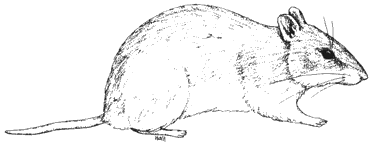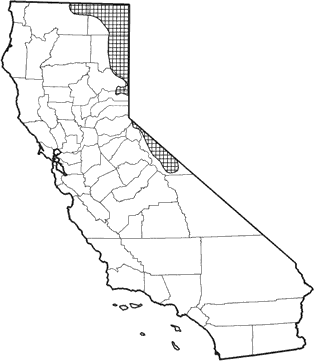
Northern Grasshopper Mouse
Distribution, Abundance, and Seasonality
Found in arid to mesic habitats in the northeastern corner of California, including eastern sections of Siskiyou, Modoc, Lassen, Plumas, and Sierra cos., and east-central California in Mono Co. Common in alpine dwarf-shrub, sagebrush, low sage, bitterbrush, alkali desert scrub, desert scrub, annual and perennial grassland, and some wet meadow habitats. Uncommon in a variety of other habitats.

Range Map
Specific Habitat Requirements
Feeding: Feeds mainly on arthropods (especially orthopteran and coleopteran insects (Bailey and Sperry 1929), but also on small mammals (e.g., Peromyscus, Perognathus, Microtus) and forbs, grasses, sedges, and seeds (McCarty 1978). Apparently shifts from warm-weather diet of animal and plant matter to cold-weather diet of much animal fat (Jahoda 1970).
Cover: Low to moderate canopy-coverage and friable soil deep enough for burrowing. Animals kept in 4.1 m? (15 ft?) enclosures dug nest burrows, retreat burrows, cache burrows, and defecation burrows (Ruffer 1965).
Reproduction: Male-female pairs excavate nest burrows, which typically are shallow (14 cm (5.5 in) below surface), and are U-shaped with an average length of 48 cm (19 in) (Ruffer 1965). The nest chamber is grass-lined. May also use abandoned burrows of other small mammals.
Water: Requires water under laboratory conditions. Probably obtains water from food in wild, especially from dew, insect larvae, and animal fat.
Pattern: Low to moderate canopy of brush with friable soils for burrowing.
Species Life History
Activity Patterns: Active year-round. Nocturnal activity is greatly reduced during full moon and during heavy, prolonged rainfall (McCarty 1978).
Seasonal Movements / Migration: None.
Home Range: Home range of 4 adult males averaged 2.3 ha (5.8 ac) (McCarty 1978). The unusually large home range is associated with its predatory life style.
Territory: Probably territorial. Both species of grasshopper mice, and both sexes, attack intruding mice (McCarty 1975, 1978). High-pitched call may serve as territorial advertisement.
Reproduction: Breeds from February to August with a peak in June-August. Gestation of 29-32 days for nonlactating females and 32-38 days for lactating females. Litter size averages 3.5 young (range 1-6). 1-10 litters per yr, averaging 5.1. Reproductively active females produce an average of 18.3 young/yr (range 2-27) (McCarty 1978).
Niche: The northern grasshopper mouse is a small bodied carnivore that preys upon arthropods and fellow small mammals. Predeliction for insect prey probably precludes much interspecific competition for food, space, or other limited resources (McCarty 1978). Predators include raptors, snakes, and other predatory mammals.
Comments: Diet suggests possible susceptibility to pesticides, but no data available. Beneficial to agriculture by consuming insect pests.
Sources & References
California Department of Fish and Game, 1999.
California's Wildlife, Sacramento, CA.
Written by: P. Brylski, reviewed by: H. Shellhammer, edited by: R. Duke
Bailey, V., and C. C. Sperry. 1929. Life history and habits of the grasshopper mice, genus Onychomys. U.S. Dep. Agric. Tech. Bull. No. 145. 19pp. Jahoda, J. C. 1970. Seasonal change in food preference of Onychomys leucogaster breviauritus. J. Mammal. 51:197. McCarty, R. 1975. Onychomys torridus. Mammal. Species No. 59. 5pp. McCarty, R. 1978. Onychomys leucogaster. Mammal. Species No. 87. 6pp. Ruffer, D. G. 1965. Burrows and burrowing behavior of Onychomys leucogaster. J. Mammal. 46:241-247.
California Animal Facts | California's Wildlife